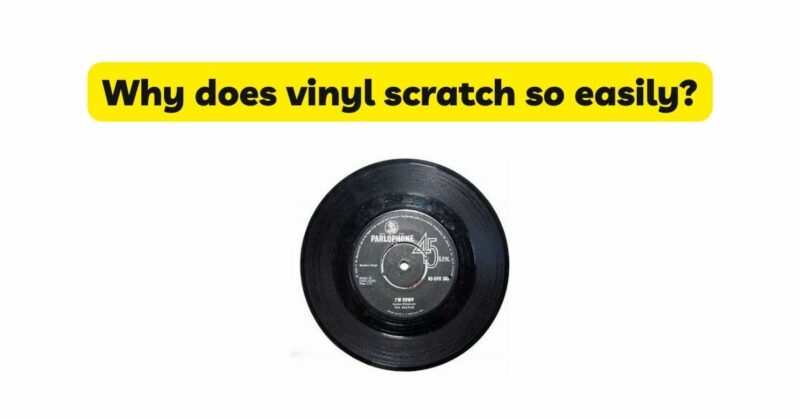Vinyl records have witnessed a remarkable resurgence in popularity over recent years, captivating music enthusiasts with their warm, nostalgic sound. However, vinyl’s delicate nature leaves it susceptible to scratching, a common issue that can impact the listening experience and diminish the record’s longevity. In this article, we will explore the reasons why vinyl records scratch so easily, examining both the characteristics of vinyl as a material and the external factors that contribute to its vulnerability. By understanding these factors, we can take proactive measures to prevent scratching and preserve our beloved vinyl collections.
- Vinyl’s Composition and Fragility
The material composition of vinyl records contributes significantly to their vulnerability to scratches. Vinyl records are primarily made of polyvinyl chloride (PVC), a relatively soft and malleable plastic compound. While PVC is an excellent medium for recording sound due to its ability to hold intricate grooves, its softness also makes it prone to damage. The following factors explain why vinyl scratches so easily:
a) Thin Grooves: Vinyl records have microscopic grooves that store the audio information. These grooves are incredibly thin and delicate, measuring just a few micrometers in width. Even a minor scratch on the groove can distort the sound quality and lead to audible imperfections during playback.
b) Surface Sensitivity: The smooth surface of vinyl records is highly sensitive to physical contact. Unlike more durable materials, such as metal or glass, vinyl can be easily scratched by relatively gentle forces. Even a small amount of pressure or friction from a foreign object can leave visible marks on the surface.
c) Abrasion Susceptibility: Vinyl’s relatively soft nature makes it susceptible to abrasion. When a foreign object comes into contact with the record, it can cause micro-tears or scratches on the surface, disrupting the integrity of the grooves.
- Dust and Debris as Culprits
Dust and debris act as primary culprits for scratching vinyl records. They introduce abrasive elements that can harm the delicate grooves and compromise the overall sound quality. Here’s how they contribute to scratching:
a) Surface Contamination: Dust particles and debris settle on the record’s surface, creating a layer of contamination. When the stylus (needle) makes contact with the contaminated surface during playback, it can push or drag the particles across the grooves, resulting in scratches.
b) Embedded Particles: In some cases, larger particles, such as tiny hairs or dirt specks, can become embedded in the grooves. When the stylus encounters these particles, it can exert excessive pressure on the vinyl, causing scratches or even permanent damage.
- Handling Errors and Mishaps
Human error and mishandling of vinyl records play a significant role in causing scratches. While vinyl is susceptible to scratching, proper handling techniques can minimize the risk. The following errors should be avoided:
a) Dropping Records: Dropping a vinyl record, even from a small height, can lead to scratches or even more severe damage. The impact can cause the stylus to skip across the grooves or leave deep gouges on the surface.
b) Placing Records on Rough Surfaces: Resting a vinyl record on a rough or abrasive surface can result in scratches. Even a seemingly smooth tablecloth or cloth can contain tiny particles that can scratch the vinyl when it is placed or slid across the surface.
c) Mishandling the Stylus: Mishandling the stylus, such as abruptly lifting or dropping it onto the vinyl’s surface, can cause scratching. Careless movements can misalign the stylus or introduce excessive force, damaging the grooves.
d) Incorrect Use of Dust Covers: Improper handling of dust covers can also lead to scratching. Sliding the cover back onto the record without aligning it correctly can result in contact between the cover and the vinyl surface, causing scratches.
- Environmental Factors
Environmental conditions can contribute to scratching on vinyl records. External factors such as temperature, humidity, and sunlight exposure can affect the integrity of the vinyl and make it more prone to scratching:
a) Extreme Temperatures: Exposure to extreme temperatures can cause vinyl to expand or contract. This expansion and contraction, especially when combined with mishandling, can lead to warping or cracking of the record, causing scratches.
b) High Humidity: Excessive moisture in the air can promote the growth of mold or mildew, which can affect the record’s surface. Additionally, high humidity can cause the accumulation of moisture on the vinyl, making it more prone to dust and debris adherence and subsequent scratching.
c) Sunlight Exposure: Direct sunlight can cause the vinyl to heat up and soften. This softening can make the record more susceptible to scratches, especially if mishandled or exposed to dust and debris during playback.
Conclusion
Vinyl records, with their unparalleled sound quality and tangible experience, have captivated music enthusiasts worldwide. However, their vulnerability to scratching demands careful handling and proactive preventive measures. Understanding the characteristics of vinyl as a material, the impact of dust and debris, handling errors, and environmental factors can empower collectors to take appropriate steps in preserving their vinyl collections. By implementing proper handling techniques, regularly cleaning records, and creating an optimal storage environment, you can minimize the risk of scratches and enjoy your vinyl records for years to come.


